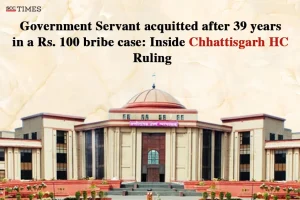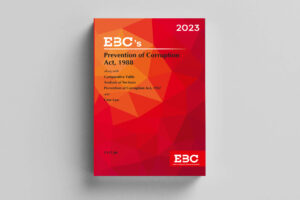Chhattisgarh High Court: In a criminal appeal filed by a former government servant who was convicted under Section 7 and 13(1) (d) read with Section 13(2) of the Prevention of Corruption Act, 1988 (‘the PC Act’) for accepting bribe of Rs 100, the Single Judge Bench of Bibhu Datta Guru, J., held that held that the failure of the prosecution to prove demand and acceptance of illegal gratification rendered the proceedings unsustainable and the charges against the appellant were not proved.
Background
In 1986, the convict was working as a Bill Assistant in the Divisional workshop of M.P.S.R.T.C. at Raipur. As a public servant, he demanded illegal gratification of Rs. 100 from the complainant for clearing his bill of arrears. Aggrieved, he made a complaint before the Lokayukta.
Accordingly, a trap team was constituted, and Phenolphthalein powder was sprinkled over two currency notes of Rs 50 each, and the complainant was directed to give them to the convict. The complainant handed over those notes to the convict. Thereafter, the trap team, along with the witnesses, caught the convict red-handed. The currency notes were recovered from him, and upon washing them in the sodium carbonate solution, they turned pink. This proved that the convict had taken the bribe.
Thus, he was convicted under Section 7 and 13(1) (d) read with Section 13(2) of the PC Act and sentenced to rigorous imprisonment for one year along with Rs. 1000 as fine.
Hence, the present appeal.
Analysis
At the outset, the Court reiterated that the complainant’s evidence must be scrutinized, and the Court must consider the degree of complicity and then look for corroboration, if necessary, as a rule of prudence. The extent and nature of corroboration that may be needed in a case may vary, having regard to the facts and circumstances.
The Court referred to M.R. Purshotham v. State of Karnataka, (2015) 3 SCC 247, the Supreme Court held that when the demand of a bribe is not proved by the prosecution, mere possession and recovery of the currency notes from the accused without proof of demand will not bring home the offence under Section 13(1) (d) of the PC Act. Similarly, in B. Jaiyaraj v. State of Andra Pradesh (2014) 13 SCC 55, it was held that it is a settled position in law that demand of illegal gratification is sine qua non to constitute the said offence and mere recovery of currency notes cannot constitute the offence under Section 7 of the Act unless it is proved beyond all reasonable doubt that the accused voluntarily accepted the money knowing it to be a bribe. Presumption against a public servant under Section 20 of the Act can be drawn only if the demand for acceptance of illegal gratification is proved.
The Court further stated that evidence on record is required to be scrutinized to find out whether the prosecution has been able to prove beyond a reasonable doubt the demand, acceptance, and recovery.
Regarding the merits of the case, the Court noted that the only evidence regarding the alleged demand in the present case was the testimony of the complainant. Therefore, in the absence of any electronic recording, the Court conducted a scrutiny of the witness testimonies to ascertain whether such a demand was made.
The Court noted that the complainant, while narrating his employment history and the litigation resulting in reinstatement, deposed that the convict had demanded Rs 100 for preparing the arrears bill. However, the shadow witness did not corroborate the allegation of demand. Though he supported the pre-trap formalities, he admitted during cross-examination that neither did he hear the conversation between the complainant and the convict, nor did he see the accused accept the tainted money. His testimony was, therefore, limited to procedural aspects of recovery and did not establish the crucial element of demand.
Furthermore, the Court noted that Nayab Tehsildar, though formally associated with the trap, conceded that he was observing from nearly 25 steps away, could not hear the conversation between the complainant and the convict, and did not personally see the convict accept the money. He further admitted several lapses in the handling of phenolphthalein powder and sodium carbonate solution, which cast doubt on the procedural integrity of the trap. The Court stated that these admissions substantially weakened the probative value of his testimony.
Similarly, the Court noted that the Investigating Officer (‘IO’) also admitted that the trap team was positioned at 20—25 yards and could neither hear the conversation nor see the convict accept the notes. He also admitted that the phenolphthalein-treated notes were not first dipped in sodium carbonate solution before their use, which is a deviation from the standard procedure. His testimony, therefore, did not bridge the evidentiary gap left by the complainant and the shadow witness.
On a cumulative consideration of these depositions, the Court held that the prosecution’s evidence regarding the demand was riddled with inconsistencies. The complainant did not affirm a clear demand at the time of the trap; the shadow witness did not witness acceptance; and the official witnesses were too far to either hear or see the transaction. What remained was only the recovery of tainted currency, which, in the absence of proof of demand, was insufficient in law to sustain a conviction. Therefore, from the above evidence adduced by the prosecution, the demand was not proved.
Regarding the acceptance of illegal gratification, the Court stated that the prosecution had relied upon the evidence of the complainant, shadow witness, independent officer, and the IO. However, a careful reading of their depositions revealed that none of these witnesses had personally seen the convict accept the money. Thus, the element of acceptance was unsubstantiated by direct ocular testimony.
As regards seizure, the Court stated that while it is true that tainted notes were recovered from the convict and his hand-wash turned pink when dipped in sodium carbonate solution, the prosecution’s evidence on this point suffered from a fundamental contradiction. The Nayab Tehsildar stated that the trap money consisted of one Rs 100 note; whereas the shadow witness and IO categorically deposed that two Rs 50 notes were treated with phenolphthalein and recovered. The complainant himself wavered between the two versions, at one stage saying that the convict demanded Rs 100 but later admitting that it was in the form of two Rs 50 notes. The Court remarked, “Such inconsistency about the denomination of the tainted notes strikes at the root of the prosecution case, as the very identity of the incriminating material is rendered doubtful.”
On the other hand, the Court noted that the testimonies of defence witnesses were significant as two of them claimed that they had seen the complainant attempting to force money upon the convict despite his refusal and even placing currency notes on the accused’s table. Their account was consistent with the suggestion that the recovery was a result of planting or thrusting, and not conscious acceptance. Another defence witness further clarified that the arrears bill could not have been prepared without prior sanction, thereby lending support to the convict’s stand that there was no occasion for him to demand or accept money.
Considering the aforesaid, the Court stated that while the seizure of tainted notes from the convict was undisputed, the absence of unimpeachable evidence of voluntary acceptance of the bribe, coupled with the glaring contradiction regarding whether the trap money consisted of one Rs 100 note or two Rs 50 notes, rendered such seizure legally inconclusive.
“The benefit of doubt must weigh in favour of the convict, as acceptance and seizure cannot be presumed in law merely from recovery without cogent corroboration of demand and conscious receipt.”
Thus, the Court held that while the factum of recovery stood proved formally, its evidentiary worth was substantially weakened in view of the absence of proof of demand, the doubtful circumstances surrounding acceptance, and the serious inconsistency about the denomination of the trap money. Consequently, the recovery, in isolation, could not sustain the conviction.
Thereafter, the Court laid down the following list of considerations to prove demand and acceptance of illegal gratification by the public servant:
-
If there is an offer to pay by the bribe giver without there being any demand from the public servant, and the latter simply accepts the offer and receives the illegal gratification, it is a case of acceptance as per Section 7. In such a case, there need not be a prior demand by the public servant.
-
If the public servant makes a demand and the bribe giver accepts the demand and tenders the demanded gratification, which in turn is received by the public servant, it is a case of obtainment. In the case of obtainment, the prior demand for illegal gratification emanates from the public servant. This constitutes an offence under Section 13 (1)(d) (i) and (ii).
-
In both cases, the offer by the bribe giver and the demand by the public servant, respectively, must be proved by the prosecution as a fact in issue. In other words, mere acceptance or receipt of an illegal gratification without anything more would not make it an offence.
Thus, the Court held that the failure of the prosecution to prove demand and acceptance of illegal gratification rendered the proceedings unsustainable, and the charges against the appellant were not proved.
“The evidence, whether oral, documentary, or circumstantial, falls short of establishing the essential ingredients of the alleged offence of bribery.”
Accordingly, the appeal was allowed, and the convict was acquitted of all charges.
[Jageshwar Prasad Awadhiya v. State of Chhattisgarh, 2025 SCC OnLine Chh 9632, decided on 09-09-2025]
Advocates who appeared in this case:
For the petitioner: Keshav Dewangan, Advocate
For the respondent: U.K.S. Chandel, Dy. A.G.


